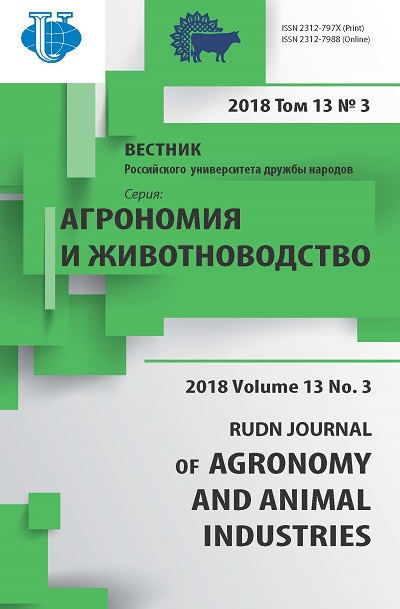OPTIMIZATION OF INNOVATIVE STRIP-TILL TECHNOLOGY OF MAIZE CULTIVATION FOR GRAIN ON BLACK SOILS IN STEPPE ZONE OF VOLGOGRAD REGION
- Authors: Ivanov V.M.1, Kubareva A.V.1
-
Affiliations:
- Volgograd State Agricultural University
- Issue: Vol 13, No 3 (2018)
- Pages: 224-231
- Section: Agricultural technologies and land reclamation
- URL: https://agrojournal.rudn.ru/agronomy/article/view/19321
- DOI: https://doi.org/10.22363/2312-797X-2018-13-3-224-231
- ID: 19321
Cite item
Full Text
Abstract
Studies carried out in steppe zone of chernozem soils of Volgograd region have established that winter wheat after fallow and maize are the best precursors for maize, cultivated for grain under strip-till technology. Growing maize after sunflower annually led to a significant decrease in crop yields. N66P32K32 turned to be the best rate of mineral fertilizers. Seeding rate of 60 thousand seeds per ha was optimal for early maize hybrids. It was found that total water consumption over the three-year period was 2653 m³/ha with fertilizer rate N66P32K32, and corn and sunflower rose to 2,700 and 2,695 m³/ha. At N66P32K32, winter wheat plants used moisture most economically. The water consumption coefficient, which shows moisture consumption for creation of a ton of produce, was 421.0 m3/t. For corn, it increased by 34.1, and for sunflower by 247.7 m³/t. In control after all precursors, moisture consumption per ton of grain sharply increased: according to winter wheat, water consumption coefficient was equal to 551.9 m³/t, corn and sunflower were 53.0 and 360.1 m³/t more. The maximum values of dry matter accumulation in 2013 and 2015 were recorded at flowering stage: depending on precursor, after winter wheat - 9.07 and 7.24 t/ha, after maize - 8.67 and 6.77, and after sunflower - 6.64 and 4.76 t/ha, respectively. Over the research years the largest daily increasing of dry biomass during germination-flowering was observed after winter wheat - 452 and 361 kg/ha, decreased slightly after corn - 432 and 337 kg/ha, and a significant decrease was noted after sunflower - 331 and 237 kg/ha. In arid 2014 season, during the period of precipitation deficit, the indicators were significantly lower. The best yield results were obtained in more favorable 2013 and 2015 research years. The studies showed that the best maize precursor was winter wheat - 5.524 t/ha. The lowest yield was obtained after sunflower - 3,456 t/ha. Moreover, maximum yield was achieved at fertilizer application N66P32K32 - 5.324 t/ha, N50P16K16 - 4.813 t/ha and in the control - 4.015 t/ha.
Keywords
About the authors
Vladimir Mihajlovich Ivanov
Volgograd State Agricultural University
Author for correspondence.
Email: ivanov-vgsxa@mail.ru
Doctor of Agricultural Science, professor, Volgograd State Agricultural University Universitetskiy pr, 26, Volgograd, 400002, Russian Federation
Anastasia Vladimirovna Kubareva
Volgograd State Agricultural University
Email: ivanov-vgsxa@mail.ru
hD student, Volgograd State Agricultural University Universitetskiy pr, 26, Volgograd, 400002, Russian Federation
References
- Petrov NY, Imangaliev KN, Davydov SV, Zenina EA. Resource-saving technology of maize cultivation for grain in Volgograd Region. Agrarnyj vestnik Urala. 2008; 52(10):52-53. (In Russ).
- Meinel T. Strip-till: Innovation Kazakhstan agriculture. Pole deyatel'nosti. 2013;(11):55-57. (In Russ).
- Dudenhoeffer CJ, Nelson KA, Motavalli PP, Burdick B, Dunn D, Goyne KW. Utility of phosphorus enhancers and strip-tillage for corn production. Journal of Agricultural Science. 2013;5(2):37-46.
- Paudel B, Radovich TJ, Chan-Halbrendt C, Crow S, Tamang BB, Halbrendt J, Thapa K. Effect of conservation agriculture on maize-based farming system in the mid-hills of Nepal. Procedia Engineering. 2014;78:327-336.
- Belyaev VI, Meinel T, Tiessen RU. Strip-till technology: design and application features of the equipment of leading global manufacturers. Bulletin of ASAU. 2013;109(11):86-91. (In Russ).
- Borisenko IB, Sokolova MV. Strip-till technology as a response to tasks of a modern farmer. Poisk innovatsionnykh putei razvitiya zemledeliya v sovremennykh usloviyakh: Materialy mezhdunarodnoi nauchno-prakticheskoi konferentsii posvyashchennoi 70-letiyu Volgogradskogo gosudarstvennogo agrarnogo universiteta i kafedry «Zemledelie i agrokhimiya»; 2014 may 14; Volgograd. Volgograd: Volgogradskii GAU Publ.; 2014. p.114-117. (In Russ).
- Kravchenko RV, Troneva OV. Effect of basic tillage on the efficiency of maize cultivation in Stavropol territory. Scientific Journal of KubSAU. 2011;71(7):680-689. (In Russ).
- DeJong-Hughes J, Vetsch J. On-farm comparison of conservation tillage systems for corn following soybeans. University of Minnesota Extension; 2007.
- Domanov NM, Ibadullaev KB, Gorokhova ZY. Agroecological efficiency of maize cultivation technologies depending on degree of intensity and weather conditions. Vestnik of VSAU. 2011;29(2):30-33. (In Russ).
- Fedorenko VP, Pashchenko YM, Dudka EL. Corn protection under intensive cultivation technology. Zashchita i karantin rastenii. 2011;(5): 17-24. (In Russ).
Supplementary files















